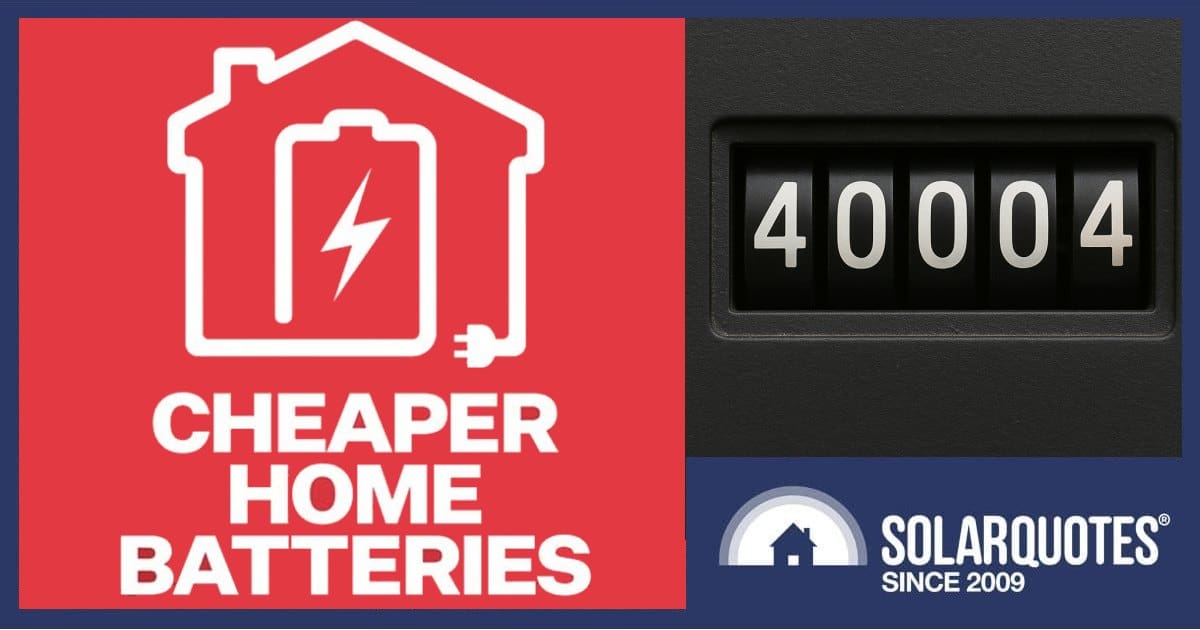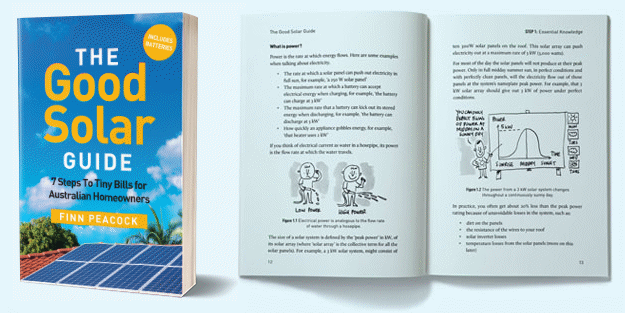
A huge number of home batteries were installed across Australia last month, and the pace doesn’t appear to have slowed down during August.
How Many Home Batteries Installed So Far?
At a press conference yesterday morning in Canberra, Federal Minister for Climate Change and Energy Chris Bowen said 40,004 batteries had been installed in just 8 weeks under the program, delivering 714 megawatt-hours (MWh) of new storage capacity. These figures indicate an average storage capacity of 17.8 kilowatt-hours (kWh).
“This is a success story of Australian households, but not just Australian households; small businesses and community groups as well,” he stated.
The minister said Australians are installing roughly one Hornsdale Big Battery a week under the program. South Australia’s Hornsdale Power Reserve was completed in 2017, originally with 129 MWh storage capacity. So, the claim is a bit optimistic (average: 89.25 MWh capacity weekly), but getting towards it.
Whichever way you slice and dice it, there has been an incredible response. So much so, SolarQuotes analysis indicates the initial $2.3bn funding pool could be depleted well ahead of schedule.
August Installs Look Set To Eclipse July
According to figures released by the Clean Energy Regulator early this month, 19,592 solar battery installations were recorded across the country during July. These installs added up to a total nominal capacity of 344.1 MWh — an average capacity of 18.2 kWh. Based on Bowen’s figures, August appears to be ahead of July in totals: ~20,400 batteries and ~370 MWh capacity, with a few days of the month left to go.
What makes August’s figures even more impressive is a bunch of batteries from July’s figures would have already been in place prior to July 1, as the Program permitted this as long as the batteries weren’t switched on.
This was allowed to avoid a ‘valley of death’ scenario in the industry after the federal battery rebate was announced in early April. Given the generosity of the incentive, which can knock thousands off the up-front cost of buying a home battery system, enquiries and sales would have pretty much stopped dead until closer to July 1 and threatened the viability of some solar businesses.
Minister Bowen said uptake was primarily an outer suburban, regional and rural story. Last week, we looked at some initial numbers provided by the Clean Energy Regulator that indicated the top 10 postcodes for battery installations were all in New South Wales at that point; except for one in Adelaide’s northern suburbs. The NSW postcodes were associated with the south-west, western and north-west suburbs of Greater Sydney, and in regional and other coastal areas of the state.
The Minister also had a message for households.
“I want to thank Australian households,” he said. “You can have all the government policies you like; unless households lean in and participate, then that policy is not going to be successful”.
It’s not just rebate recipients who will benefit, but the wider electricity system as well. The batteries will reduce strain on the grid and put downward pressure on wholesale electricity prices; particularly during peak evening periods — and that benefits everyone.
Home Battery Rebate: The Absolute Basics
Available across Australia, the Cheaper Home Batteries program rebate is available to households, businesses and community organisations also installing a new or with an existing solar power system; to which the battery must be connected.
The scheme currently cuts the cost of eligible solar batteries by around $330 per usable kWh after admin fees and charges1 and is offered as an up-front discount. The support level is to be reviewed at least annually and will gradually decrease until 2030, after which the program ends.
Systems using Clean Energy Council approved batteries (and inverters) with a nominal/total capacity of 5 kWh to 100 kWh are eligible, but the discount only applies to the first 50 kWh of usable capacity2, which is far more than most households would install. The battery must be Virtual Power Plant (VPP) capable, but connecting to a VPP isn’t mandatory.
Footnotes
- And if you’re in Western Australia, the WA battery rebate can be combined for extra savings, but it has some extra hoops; including compulsory connection to a VPP. ↩
- Jargon buster – discover the difference between nominal and usable battery capacity here. ↩

 RSS - Posts
RSS - Posts



I’m not so sure that the companies that have to buy the Small-scale Technology Certificates (STCs) to fund all this are also feeling the love.
For the Cheaper Home Batteries Program the federal government is purchasing the STCs.
My mistake – I muddled up with Large Scale Generation Certificates. As far as spending taxpayer monies go, I guess this is at the better end of the spectrum. Tough luck though for renters, apartment dwellers, or the not well-off left supporting the bulk of what continue to be ever-increasing grid costs.
Tony,
In NSW and VIC, there are government subsidies to install solar on appartement blocks.
I’m pretty sure the other states will follow suit.
Looking forward to the Rebate cheques flowing out from the program.
I have always said, with household rooftop photovoltaic systems, that it is we who have been propping up the (at least the SWIS) grid – we caused the end of the rolling blackouts in summers gone by. The installation and use of behind the meter battery storage, reinforces this, and, is quicker to commission, and, provides more reliable supply to households, than grid level large battery systems.
Regarding the “Last week, we looked at some initial numbers provided by the Clean Energy Regulator that indicated the top 10 postcodes for battery installations were all in New South Wales at that point; except for one in Adelaide’s northern suburbs.”, it would be more meaningful and useful, for the comparisons to be expressed in terms of BESS installations, and, capacity, relative to the number of households and/or people, in each postcode, rather than simply the absolute number per postcode.
A greater population with lower average intelligence does not mean the people are more intelligent.
‘The support level is to be reviewed at least annually’.
I had assumed it would be like the SRES and reduce in a linear fashion.
That could be interesting if they tweak it too much early on.
The uptake should ease a lot of grid issues, and within NEM states in particular, the very harmful (to retailers) spikes during peak.
But they must soon start offering better variable FITs, or lose customers to Amber and other such wholesale models.
If they aren’t greedy with peak FITs wanting to keep them as low as here in SA at 2c, but pay a decent number, they can avoid huge mwh costs and still make their margins.
Everything will be more stable for all consumers, and then the SHOULD be able to pass on growing lower tariffs to those without the benefit of solar / battery owners.
Will they ?
I guess the AER has to control that pretty tightly ?
The solar power, comes in at the wrong time, the solar peak, they have their own supply of solar. But battery feed in tariffs, would be higher, because they’d come in during peak demand. So if you want good feed in tariffs get a big battery, the federal and state governments. Will pay, for half of it, because you’re paying for half of it, co investment, you’ll not only be reducing your power bills, but assisting your community with power reliability. And quite reasonably getting paid, a reasonable time of power premium.
What irritates me is, I get a monthly demand penalty charge calculated from the one day of the month during the peak window when the highest 30-minute period of consumption occurs, between 3pm and 9m in Summer, seven days a week. On sunny days, my system is still exporting from 3pm to 7pm, the first four hours of this period, yet they justify paying me only 4c kW/h, for this exported power, by whining there excess power on the grid during this period
Which is it, too little so therefore we need to be penalised for using it, or too much so we need to discourage from exporting power? I get I am lucky to have some west facing panels, so maybe 3pm is fair enough over the whole system, but they should then be paying a higher FIT from 3pm to thank exporters for helping during a demand period.
Basically, the FiT for battery exports into the peak has to be at least 15c/kWh, probably more like 20c, to get people to stay on traditional tariffs instead of the likes of Amber. That is the levelised cost of storage (LCoS) of a decent battery after rebate, as in, the amount you pay up front for that cyclable kWh based on the warranty. It will need to be 15c more than the cheapest time of day once battery-only (not coupled to solar) starts coming in.
This is doable, but probably won’t be done because it would probably need some market tweaks.
Battery only will not be eligible for the federal subsidy, so I expect their uptake to be negligible, at best…
What an excellent program this is. It provides short and long term benefits to householders, stabilises and grows the network through increased household solar and battery installs, reduces the total need for network firming and expansion ie less transmission costs and contributes to meeting emissions targets.
I will soon seek quotes for expanding my 7kw Fronius/9.2kwTrina 3 phase system to about double with a matching Sigenergy battery most likely. Since I have plenty of NW facing roof space my situation is ideal.
I can confirm that it is the government’s incentive scheme that has brought forward the timing and increased the size of this upgrade.
A new age has begun. An age of energy freedom and abundance.
Back in the day, the giga factory, that made a gigawatt hour, of batteries, well we thought that was magnificent. But in the last 3 months, Australians, a country, with only 27 million people, installed a gigawatt hour of batteries. A quarter, of a year and 1/300th of the world’s population, installed gigawatt hour of power storage.
Things are happening quite quickly, Nepal’s car sales are 75% electric vehicles and the highway from Lahasa Tibet and Kathmandu Nepal hasn’t even been completed, that’s next year. China is an electro State, oil consumption is down 12% in one year. there are rumors, of a half a billion tonnes find, of lithium, in the Chinese desert. $10 a kilowatt hour, sodium batteries, electric vehicle motors, that can fit in the wheel hubs, solar panels are so cheap, the Germans use them, for fences.
Let’s keep some perspective. International Energy Agency (IEA) estimates for 2024 – total global electricity generation of approximately 29,600 terawatt-hours (TWh).
That’s 29,600,000 Gigawatts vs 1 Gigawatt in 3 months by 1/300 the world’s population, albeit in one of the richest countries in the world.
Let’s generously assume the world is equally rich – * 300 population * 4 quarters *1 Gw/ qtr =1,200 vs 29,600,000 Gigawatts/ year and rising fast.
Infinitesimal, and needs to be replaced every couple decades. Sure, it’s all nice and shiny, but it isn’t the answer
Hi Tony,
A lot of people who should know better have laughably underestimated renewable deployment.
In 2024, the world installed over 7 GW of new nuclear power capacity, which was a huge uptick of 33% compared to 2023. This brought the total global installed nuclear capacity to around 420 GW as of early 2025.
China alone added new solar PV capacity at roughly:
216GW in 2023
277GW in 2024
212GW for the first half of 2025 alone; most projections for the full-year 2025 expect a total of 300 GW to be added, even with a second-half slowdown.
It took 60 years for the world to install it’s first Tearrawatt of solar and less than two years to install the second Terrawatt
https://climateenergyfinance.org/wp-content/uploads/2025/02/MONTHLY-CHINA-ENERGY-UPDATE-Feb-2025.pdf
https://taiyangnews.info/markets/china-solar-installations-4m-2025
What a time to be alive!